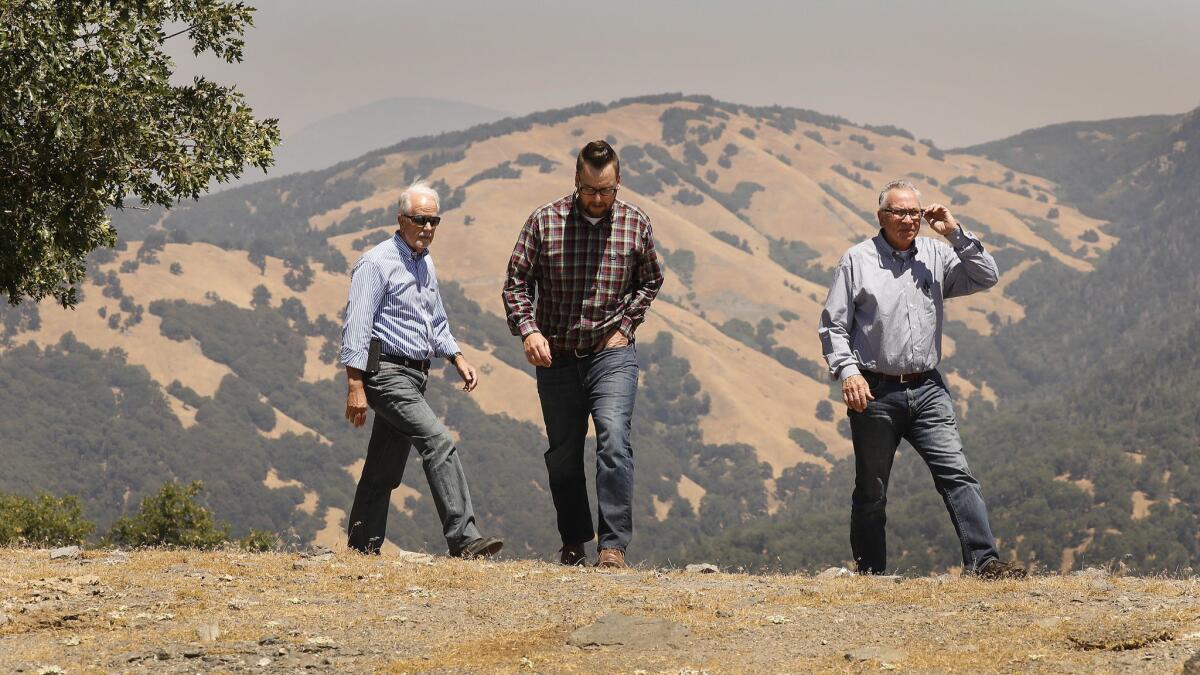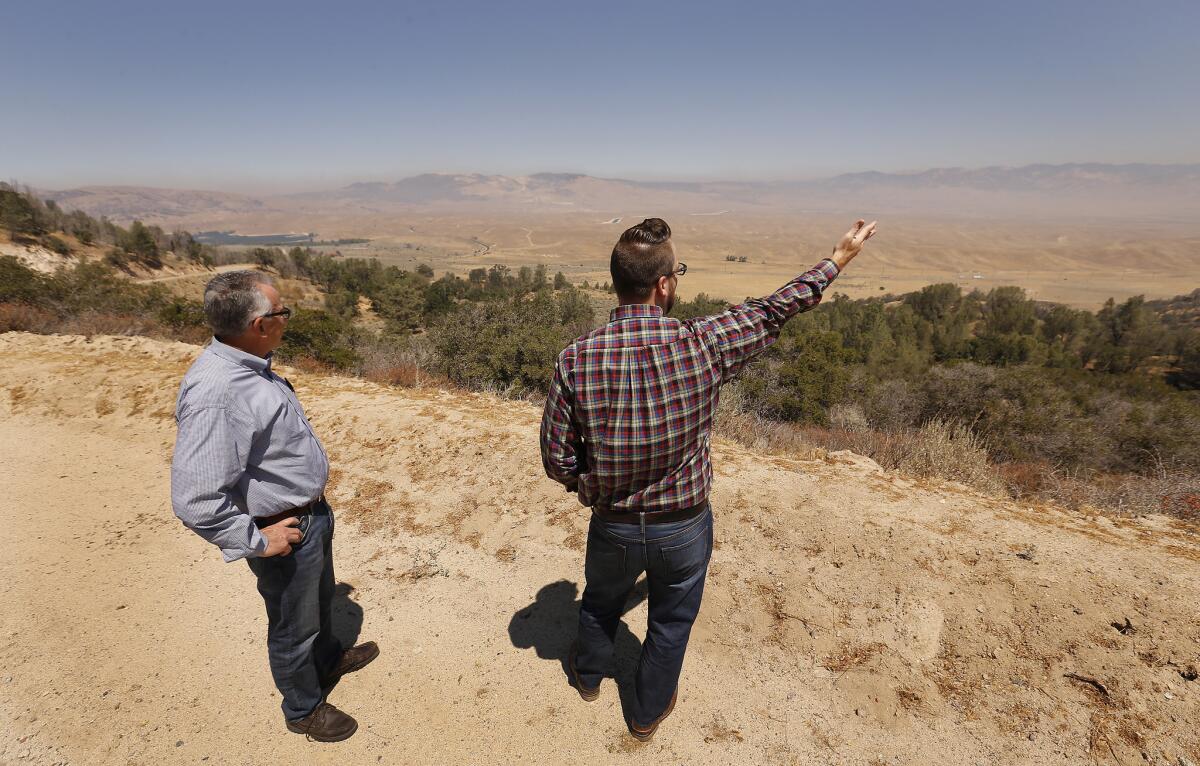Building a vast new city on L.A.’s northern edges: A solution for region’s housing crunch?

Up near the top of the Grapevine, where Los Angeles and Kern counties meet, sits the largest contiguous expanse of privately owned land in California.
Sprawling grasslands sprout native and non-native species. Joshua trees with spiky branches clump together. At higher elevations, oak and pine forests blanket hillsides in a thick, green velvet, providing a home to deer, black bears and elk.
Tejon Ranch, a 270,000-acre plot, is one of the last frontiers of relatively undeveloped space in the Los Angeles region.
That may soon change.
After years of planning and debate, as well as real estate busts and booms, the Centennial development is set to come before L.A. County’s Regional Planning Commission for possible final consideration Wednesday. It will later be taken up by the Board of Supervisors.
The master-planned community is the latest in a long line of predesigned suburban and exurban developments that have defined Southern California for decades: Leimert Park, Irvine, Valencia and, most recently, Newhall Ranch, a 21,500-home project partly approved in 2017.
But discussion around such developments has shifted over the years, as Los Angeles and much of the country reconsider urban life and as the imperatives to address climate change, an affordable housing crisis and ever-worsening traffic grow more urgent.
At a time when many planners are urging denser developments in the urban core near transit lines and job centers, Centennial is a throwback to a much more traditional form of development in California. It would create a whole new community on the fringes of the city, extending Southern California's suburbs outward to now remote, empty land.
“Tejon Centennial is really part of a classic California story,” said Stephanie Pincetl, a professor of the environment and sustainability at UCLA. “The consequences of that kind of exurban land development are becoming more and more apparent.”
The debate over the project sits against the backdrop of a broader conflict across Los Angeles about how to accommodate a growing population: Southern California desperately needs more housing, especially with rents and home prices rising fast. But Centennial presents a type of middle-class living — spacious homes in a far-flung suburb — that some planners say feels anachronistic.
“We are not using our urban fabric very well, and instead we jump out to the suburbs or beyond the suburbs,” Pincetl said. “We haven’t grappled with really living in a city.”
Centennial backers argue that the new community is exactly what Southern California needs, saying the market is best served by a mix of new suburban tracts and denser living in apartments and condos in urban areas.
L.A. is in the midst of a residential building boom that is transforming areas such as downtown, Hollywood, the Westside and Miracle Mile with high-rise and mid-rise complexes. Developers say Centennial offers options for buyers who want a house in a suburb at a realistic price.
“The debate is a false dichotomy. It doesn’t have to be either/or — it can be both,” Barry Zoeller, vice president of corporate communications and investor relations for Tejon Ranch Co., said while navigating a Chevy Suburban over dirt roads on the flat, windy land where Centennial, if approved, will be built.

The site, about 70 miles northwest of downtown Los Angeles, encompasses approximately 12,000 acres south of where the California Aqueduct branches east and west. In summertime, it is hot and dry; in the winter, snow occasionally dusts the sage brush across the landscape.
Centennial would bring in up to 19,333 residences — a mix of single-family, multi-family and apartment units — with a business park and open space around the periphery. Tejon Ranch executives estimate a single-family house would cost $425,000 to $550,000.
First proposed nearly two decades ago, the project was held up for years by environmental opposition. Tejon Ranch agreed in 2008 to set aside 90% of its holdings for permanent preservation in exchange for environmental groups’ promise not to oppose development.
Standing on a hillside overlooking the Centennial site, Zoeller described how the developer had pulled back from oak woodlands and riparian areas and scaled down from an original target of 23,000 units to accommodate environmental concerns. Nathan Keith, director of planning, pointed out where wildlife corridors would be built to allow unfettered movement for badgers, foxes, coyotes and mountain lions.
Still, the project continues to be contested by environmentalists who did not sign on to the agreement, including the California Native Plant Society and the Center for Biological Diversity.
“This ranch is a really special place — there are a myriad of habitats and … some 900 native plant species,” said Nick Jensen, a conservation analyst with the plant society.
“The destruction of 5,000 acres of that habitat ... is a destruction we cannot accept,” he said.
Environmental advocates also point out that the project’s location — far from the urban centers of Los Angeles, Santa Clarita and the Antelope Valley — and the infeasibility of extending rail service to Centennial will increase the miles people drive, producing more greenhouse gas emissions, air pollution and traffic.
“It’s exactly the wrong sort of development for our region,” Bryn Lindblad, of the nonprofit group Climate Resolve, said at a hearing in June.
Zoeller disagrees.
“What looks isolated and out there today, in 25 years looks like a really wise decision,” he said, citing a severe housing shortage and projected population growth.
According to the Southern California Assn. of Governments, the six-county region of Southern California (excluding San Diego) falls about 600,000 homes short of demand — and is expected to add nearly 4 million people by 2040.
The association’s regional transportation and community development plan envisions a future in which people live closer to jobs, schools and entertainment, and walk, bike and take public transit more often.
Still, said the association’s executive director, Hasan Ikhrata, communities like Centennial have a role to play.
“There will not be enough land and not enough cities around … to accommodate more than half of the growth within transit-quality areas,” he said. “It’s not only physically impossible, it’s also politically impossible.”
The association encourages developers to build more densely and to include local jobs and amenities so people don’t have to drive as much.
Tejon Ranch says that’s exactly what it has in mind.
The company has repeatedly touted Centennial as a “self-sustaining community” that will offer people a place to “live, work and play.” The project includes 10 million square feet for commercial, business and civic uses, as well as plenty of open space and public parks.
Planning documents submitted for the project, which will take 20 years to complete, say it will generate at least one job for every dwelling unit, with job creation phased in starting three years after housing construction begins.
Somjita Mitra, an economist with the Los Angeles County Economic Development Corp., said jobs at Centennial will probably span industries and incomes, from food service and retail to manufacturing and engineering.
“It’s really an idea of ‘if you build it, they will come,’” Mitra said.
Even if a developer is successful at recruiting employers, “there’s no guarantee that people buying in the master plan will work in that [job] center,” said Victoria Basolo, a professor of urban planning and public policy at UC Irvine.
In Santa Clarita, for example, 75% of residents commute out, while only 25% work within the city, according to the Southern California Assn. of Governments. The percentages are similar for Lancaster and Irvine.
“What you have [then] is the drive, the commute to job centers,” Basolo said. “We’re better served connecting our housing to rail.”
She added that for every high-paying job in medicine or computer technology that the project may bring, three low-paying jobs in services will follow.
“The system breaks down if you have no housing for the people who do service jobs,” Basolo said.
Tejon Ranch has committed to including 10% “affordable” units, but has not defined the mix of low- and moderate-income housing.
That’s something that may be worked out when the project comes before the Board of Supervisors.

Supervisor Kathryn Barger’s office has directed the developer to build a full suite of municipal facilities, including sheriff’s and fire stations, urgent medical care and a public works yard, as well as to provide viable transit options for people commuting offsite, such as bus or shared-ride services, said Chris Perry, Barger’s planning deputy.
The supervisor has not indicated how she will vote. But Perry said she generally is supportive of projects on private land that are consistent with land-use plans and local and state regulations while mitigating negative environmental impacts.
Regardless of whether this particular project is approved, it may be the last remnant of a bygone era.
“We do not expect to see many future developments like Centennial, like Newhall Ranch,” Ikhrata said. “There’s no place for it to happen.”
Twitter: @AgrawalNina
Sign up for Essential California
The most important California stories and recommendations in your inbox every morning.
You may occasionally receive promotional content from the Los Angeles Times.








